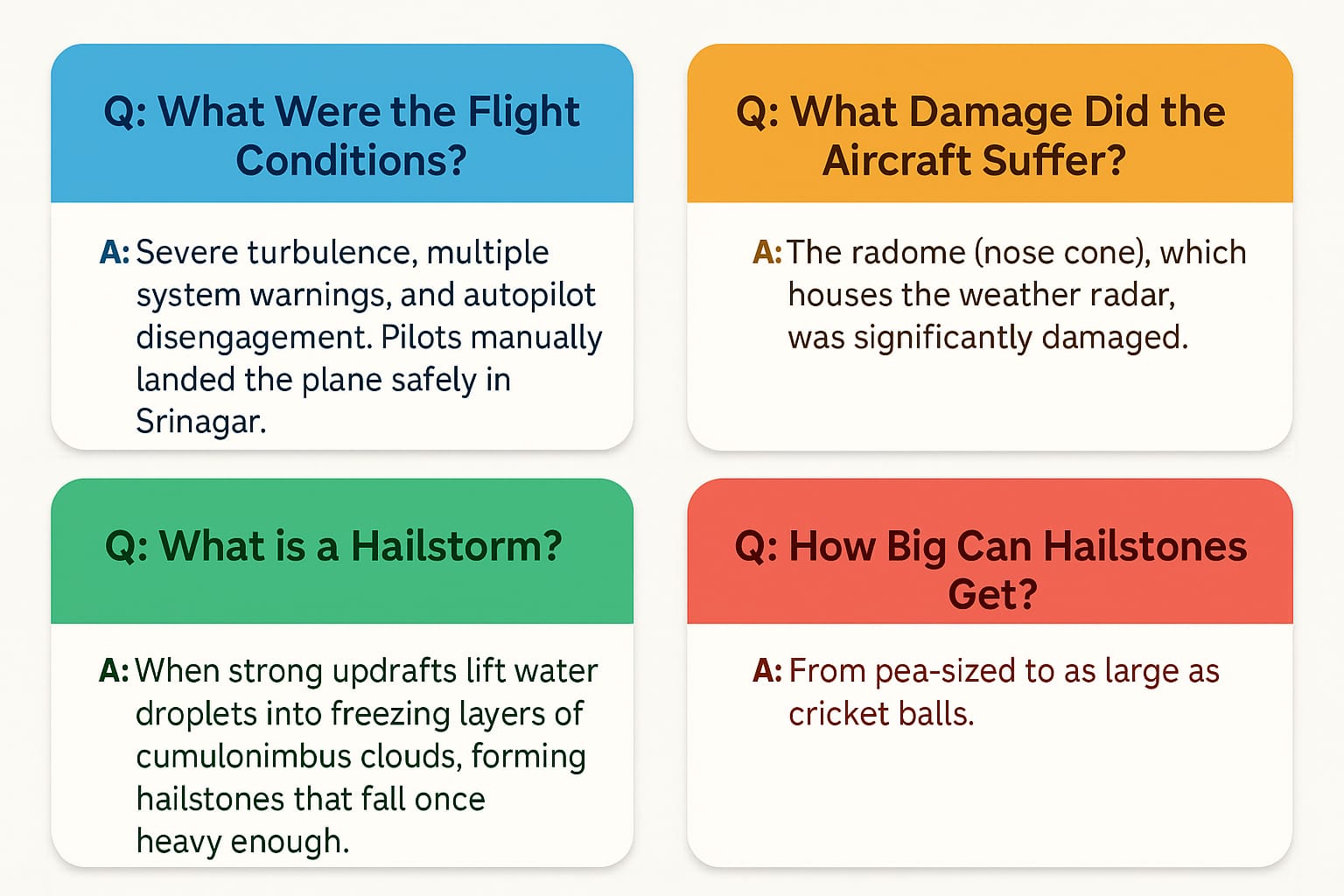IndiGo Flight Faces Hailstorm and Turbulence: A Near-Death Experience
IndiGo Flight Faces Hailstorm and Turbulence: A Near-Death Experience
In the latest aviation current affairs, an IndiGo airlines flight (IndiGo flight 6E 2142) operating a Delhi-Srinagar flight encountered a severe hailstorm and turbulence on May 21, 2025, forcing pilots to make split-second decisions that prevented a disaster. This flight news today holds significance for aspirants preparing for UPSC, SSC, CAPF, and other competitive exams under topics such as disaster management, technology, and India’s air defense and civil aviation systems.
What Happened in the IndiGo Flight Incident?
The IndiGo 6E flight with 220+ passengers on the Delhi-Srinagar flight encountered a hailstorm near Pathankot, leading to extreme weather conditions similar to those causing the weather in Poonch. The pilots requested a route deviation to avoid danger, resulting in a series of events that nearly led to an indigo flight emergency landing:
- The Indian Air Force (IAF) denied entry into restricted military airspace near the Line of Control, which is close to the international border.
- The Lahore control in Pakistani airspace also refused deviation, citing an active NOTAM banning Indian aircraft.
The aircraft faced severe turbulence in flight and system warnings.
- Autopilot was disengaged, and the pilot plane control switched to manual operation.
- Despite the challenges, the plane made a safe landing at Srinagar airport, though the radome (nose cone) suffered heavy aircraft nose damage.
- The Director General of Civil Aviation (DGCA) has launched an official probe into this airline news incident, which could have potentially become a plane crash today india headline.
What is a Hailstorm?
A hailstorm is a violent weather phenomenon where ice pellets (hailstones) form in thunderclouds and fall to the ground. These hailstones can range from pea-sized to as large as cricket balls. They form when updrafts carry water droplets into freezing zones within cumulonimbus clouds. Layer upon layer of ice builds until gravity forces the hailstones down, often causing the need for weather diversion in aviation.
What is Turbulence in Aviation?
Turbulence refers to irregular or unpredictable air movement that shakes the aircraft mid-air. It can be caused by:
- Weather systems (like thunderstorms or hailstorms)
- Jet streams
- Mountains (creating wind shear)
- Clear air turbulence (invisible and most dangerous)
Turbulence may feel like jerks or drops and can:
- Dislodge passengers or crew
- Cause injuries
- Force autopilot disengagement
- Social media posts often feature turbulence videos, highlighting the intensity of such experiences for passengers.
Impact of Hailstorms on Aircraft and Flight Operations
The hailstorm effect on aircraft can be severe and multifaceted:
Structural Damage: Hailstones can damage the aircraft’s nose cone, windshield, wings, and engine surfaces.
- Windshield Damage: Cracks or visibility loss for pilots.
- Engine Damage: Hail ingestion into jet engines can lead to engine failure or flameout.
- Autopilot Failure: Sudden weather shocks can force autopilot systems to shut down, requiring manual control.
- Turbulence: Causes rapid altitude loss or gain, risking passenger safety.
- Flight Delays and Diversions: Aircraft may be rerouted or grounded to avoid storm zones.
- Passenger Panic and Discomfort: Especially during high turbulence or hail impact, sometimes leading to religious supplications.
- Maintenance and Inspection Delays: Post-incident maintenance inspection is mandatory, often leading to aircraft grounding and affecting airline schedules and costs.
Why This Matters for Competitive Exams
- Highlights aviation safety and disaster management, relevant to UPSC GS Paper III, CAPF Paper II, and SSC Current Affairs.
- Explains real-world applications of weather science, technology, and international airspace rules.
- Useful for essay writing, Ethics and integrity, and interview questions involving risk management and civil-military coordination.
- Demonstrates the importance of air traffic controllers and flight crew protocol in emergency situations.
Illustrates the complexities of international borders and overflight clearance in aviation.
This IndiGo news incident, now part of india news today, serves as a prime example of how weather conditions, geopolitical factors, and quick decision-making play crucial roles in ensuring passenger safety in modern aviation. It also underscores the importance of continuous improvement in aircraft design, weather forecasting, and pilot training to handle such near-death experiences effectively.
The incident highlights the critical role of air traffic control, including the Northern Area Control Centre and Lahore control, in managing international airspace and responding to emergencies. As the emergency reported by the IndiGo flight unfolded, it brought attention to the delicate nature of aviation operations near international borders, especially in regions where cross-border shelling has been a historical concern.
In the aftermath of this incident, Srinagar airport news today focuses on the safe landing of the aircraft and the ongoing investigation. This event serves as a reminder of the unpredictable nature of aviation and the constant need for vigilance and preparedness in the face of extreme weather conditions and geopolitical challenges, particularly for flights operating near the international border between India and Pakistan.









